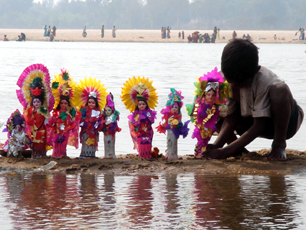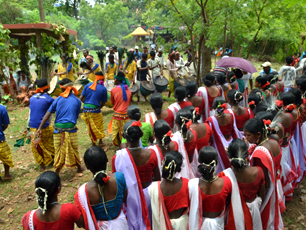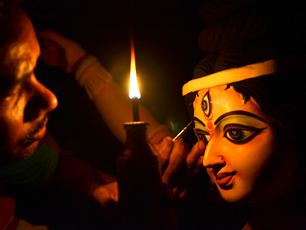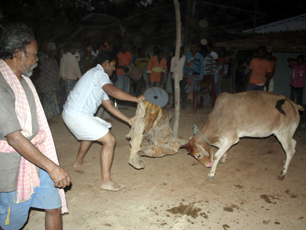Fairs & Festivals

Tusu & Makar Parab
Tusu is a harvest festival held during the winter in the last day of Poush (January). Tusu songs being associated with harvesting, always refer to the householders wealth - 'ghee of 32 cows', 'rice of fine paddy', 'pots of ghee and gur' are some of the expressions used. The villagers pray to the Folk Goddess Tusu for prosperity. They ask for the Goddess's blessings so that their homes and the homes of their sons may overflow with wealth.These songs reflect the simplicity and innocence of the santhals, kurmis and the mahatas. Cockfighting is a tradition observed by the local community during this festival.'Sankrat' or 'Makor Parab' is a social festival of the santal community. This festival follows 'Johorai' and continues for 2-3 days. Rice Beer or brew, meat-cake and fowl are the staple items in the menu of the festival. Home-made cake, molasses-flattened rice and parched rice are offered to 'Marangburu' in a gesture of worship. On this occasion it is a standing custom with the Head of the family to offer home-made drink i.e. 'hariah' in memory of the forefathers. On the occasion of their festival the members of the santal community go for collective hunting with traditional weapons like bow and arrow and participate in the community dance with arms. This festival is of immense importance as it promotes and boosts get-together.

Baha/Saharul
The 'Baha' Festival is celebrated during spring season (April-May). It holds an important place in the life of the Indian ancient communities particularly the Santal, Munda, Hoe, Oraw and so on.The term 'Baha' connotes 'Flower'. This festival is also known as Sarul or Sarhool. At the advent of the leafy spring when nature wears a beautiful festival look with the new flower and foliage 'Baha' festival is celebrated. 'Marang Buru', 'Joher Ayu', and Mamrek, the tutelary God and deity of the Santal community are worshipped on the occasion.
On the eve of the worship oom or 'sinnan' ritual is performed and the dwelling places are cleaned and made holy. The next day the priest or Naikke performs worship. At every house the Naikke is offered the best possible reception and his legs are washed with real earnestness. In a gesture of religiosity and goodness the 'Naikke' favours them with flowers. On this occasion worship is offered at the foot the 'Joher Garrhe' (living 'Sal' tree). The worship is marked by the sacrifice of four cocks in praise of 'Maragnburu'. Moreover, a dappled cock is sacrificed for 'Jahir Era' - the mother of the race. A black cock is sacrificed for 'Gonsain Era' residing in the 'Sal' tree and finally a goat is sacrificed and offered to the 'Manji Haram' (the village chief).
The 'Baha' festival is celebrated for three days. The opening day is called 'Unm' or cleaning and sanctifying the dwelling houses and surrounding. The second day is popularly known as 'Sar Dimaha' or the main Baha festival and the third or the final day is called as 'Sendra' or the Day of Hunting.
It is quite interesting to note that when the 'Naikke' makes for the altar to perform rituals and worship, the young men and women honour him by their traditional community dance and music against the lush-green sylvan beauty.

Karam Parab
The festival is chiefly based on aspiration of the people for child and the success of cultivation. This festival of the people is celebrated on "Bhadra Ekadashi", a day from Bengali calendar. This festivity is inherently of the people of Jhargram, Kurmi, Bagal, Kumor, Kandhaity etc. In the yester night of the festival, Karam tree is being worshipped and all around so that no one can cut any branch of the tree. Only one branch is being cut out and worshipped. This no doubt worshipping of the trees, as trees yields us with all the fundamental necessities as food, oxygen etc. On the next day of the puja the branch is being immersed in the river. This puja is mainly done by the unmarried girls. They sing a song dedicating the God. The essential ingredients are sprouted "chola, moong, matar, kalai" etc. The aboriginals believe praying to God in this Puja fulfils their wishes.
Bhadhu
Bhadu is a festival celebrated during (August-September) and related to early rice harvest. Colorful processions by women while singing enchanting songs in memory of Bhadreswari or Bhadu, the princess of Kashipur in neighboring district of Purulia who transformed herself into a cult figure. She was dearly loved and even worshipped by the villagers as the Goddess of Crops. As the rains pour down on the red earth, voices rise in praise of Bhadreswari Ma, invoking her blessings for a good harvest.Indra Puja
This festival is a four hundred years old traditional festival celebrated with great splendor before the Durga Puja. Here Lord Idra is worshipped in the form of a huge sal tree log cut fresh every year from the nearby forests and erected for rituals, usually praying Lord Indra for good rainfall, harvest of crops and prosperity. Earlier the festival used to stretch for about a week and a famous Ind Mela(Fair) was organized. The rituals of Indra Puja are still organized and performed by the Rajbari in Jhargram.
Durgapuja
Durga puja is regarded as the most important festival of Jhargram during in the Bengali month of Aswin (September-October). The town is dresses up in a new look for the five days of the festival. The celebration lasts for five days starting from Maha Shashti (the sixth day) and ends with Bijoya dashami (the tenth day). The first day of the celebration starts with Maha-Shashti, which is like welcoming Goddess Durga and ends with immersing the idols in the nearby lakes, ponds or rivers on the evening of Dashami. The clear blue sky, the cool pleasant air, the beautiful fragrance of sal and mahua forests, the lush green paddy fields and chanting of mantras of Goddess Durga, all sum up together to create the perfect ambience for the celebration. The preparations for the festival are done way in advance as beautiful pandals are build in different areas of the town,some of the important pandals are Sanghamitra Samity, Purbasa, Ghoradhara, Kanagali, Old Jhargram and Officers Club these are mainly community pujas, which are mainly financed by the local people or sponsorship from big corporate houses. People from all religious background participate in it and is celebrated as a secular festival.On the day of Bijoya Dashami Ramlila is organized and an effigy of Ravana is burnt in Old Jhargram. Other cultural programmes are organized in different parts of Jhargram and there is feast and music in the environment. During this festive period Jhargram attracts tourists not only from Kolkata but also from other states.
Bandna (Saharai)
This festival is one of the most famous festivals celebrated during the day of Kartik Amavasya (November). This festival is mainly for the animals. Tribals are very close with animals and pets. In this festival, people wash, clean, paint, decorate feed well and put ornaments to their cows and bulls. The song dedicated for this festival is called Ohira which is an acknowledgement for animal's contribution in their day-to-day life. The belief behind this festival is animals are integral part of life and have souls as human being do. Generally the colours used for decorating animals are natural colors and artwork is of folk type.Saharai festival is the natural festival of harvest of the santal community. When the paddy fields look luteous (with fullness and mellowness), the community feels elated with joy and celebrates 'Saharai' with heartiness.
The festival chiefly means admiration and gratefulness to 'Ma Bhagabati' or the cows and bulls. After the harvest is reaped the santal community feels joy and jubilation which they like to share with the cows and bullocks that aided the process of agriculture. Many are under the conception that 'Saharai' actually means progress and prosperity. This why the above festival is celebrated by the community with as eye to achieve social and community progress and prosperity. It can be mentioned relevantly that the santal community residing in the southern part of India - comprising parts of Orissa, Singhbhum, Midnapore and Southern parts of Purulia and Bankura, celebrate this festival along with 'Kalipuja' festival.
This festival observed for five days and nights offers the young men and women scope for free mixing with the prior permission of 'Jog-Majhi'. In the santal community the occasion for rejoicing are chiefly controlled by Majhi (village chief), godeth (messenger of 'Majhi'), Naikke (proest) and Koledum Naikke.
'Saharai' festival lasting for five days represents five different rituals each day. On the opening day the first item 'oom' (cleanliness) is observed. The second day is known as 'Bonga Maha' or the day of worship. The third day programme is known as 'Khuntao Maha'. The fourth day programme is called 'Lemaha' and the fifth day celebration is termed as 'Gadai Maha'.
The Saharai festival is undoubtedly an important occasion for healthy get together. This gives the community members ample scope for drinking and being soothed by community music and dance. The 'Naikke' worships 'Gottandi' in a scheduled spot located outside the dwelling house while the female members draw different pictures of creepers on the mudwalls with different colours.
Saharai is a colourful festival of rituals and rejoicings, dancing and drinking. Interestingly the 'Saharai' songs are pregnant with elfin touches of spiritual rings of the 'Bauls' in Bengal.

Abge Bonga
With a view to getting relief and respite from dangers and diseases the santal community worships 'Abge Bonga'. This worship is performed annually but some worship this Bonga in the Bengali month of 'Agrahayana' and 'Ashara'.Abge Bonga is worshipped at every house. It is the firm conviction of every member of the santal community that failure to keep up promise of special offering 'Manat' to Bonga will certainly incur his wrath that may harm the concerned family. It also transpires from the prevalent popular belief that if the evil spirits manage to get hold on the family, it would be definitely disastrous for the members. This is why the santals try to please 'Abge Bonga' with animal sacrifice. But eating mutton of the sacrificed ram is strictly prohibited for the women. Moreover, the worship of Abge Bonga is not performed at home, it is performed outside the house preferably near a pool of water.

